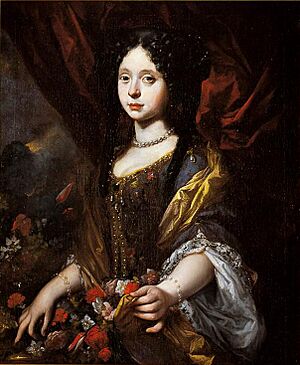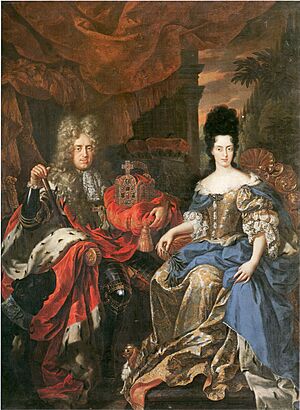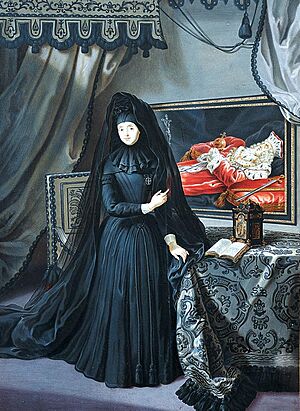Anna Maria Luisa de' Medici facts for kids
Quick facts for kids Anna Maria Luisa de' Medici |
|
|---|---|
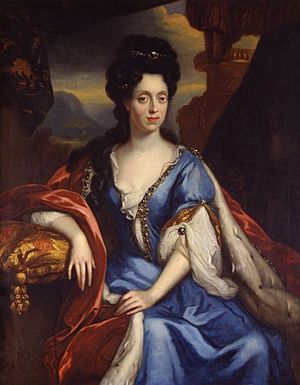
Portrait by Jan Frans van Douven
|
|
| Electress Palatine | |
| Tenure | 5 June 1691 – 8 June 1716 |
| Born | 11 August 1667 Palazzo Pitti, Florence, Tuscany |
| Died | 18 February 1743 (aged 75) Palazzo Pitti, Florence, Tuscany |
| Burial | Basilica of San Lorenzo, Florence 43°46′30″N 11°15′13″E / 43.774991°N 11.253659°E |
| Spouse | Johann Wilhelm, Elector Palatine |
| House | Medici |
| Father | Cosimo III de' Medici, Grand Duke of Tuscany |
| Mother | Marguerite Louise d'Orléans |
| Religion | Roman Catholicism |
Anna Maria Luisa de' Medici (born August 11, 1667 – died February 18, 1743) was an important Italian noblewoman. She was the last direct descendant of the main House of Medici family. The Medici were a very powerful and wealthy family in Florence, Italy.
Anna Maria Luisa was a great supporter of the arts. She gave the Medici family's huge art collection to the Tuscan state. This collection included famous works from the Uffizi, Palazzo Pitti, and other Medici homes. She made sure that none of these artworks could ever be taken out of Florence. This act helped make Florence a world-famous art city.
She was the only daughter of Cosimo III de' Medici, Grand Duke of Tuscany. Her mother was Marguerite Louise d'Orléans, a niece of Louis XIII of France. Anna Maria Luisa married Johann Wilhelm, Elector Palatine. This made her the Electress of the Palatinate. She supported many musicians, making the court in Düsseldorf a famous music center. She and her husband did not have children. This, along with her brothers not having children, meant the Medici family line was coming to an end.
In 1713, her father, Cosimo III, tried to change the laws so Anna Maria Luisa could become the ruler of Tuscany. But other European powers did not agree. In 1735, Francis Stephen of Lorraine was chosen as the next ruler instead. After her husband died, Anna Maria Luisa returned to Florence. She lived a quiet life and helped complete the Basilica of San Lorenzo, where she was later buried. Her death in 1743 marked the end of the Medici family's rule in Tuscany.
Contents
Anna Maria Luisa de' Medici: A Royal Life
Early Years and Family
Anna Maria Luisa de' Medici was born in Florence on August 11, 1667. She was the second child and only daughter of Cosimo III de' Medici, Grand Duke of Tuscany. Her mother was Marguerite Louise d'Orléans. She was named after her aunt, Anne Marie Louise d'Orléans, Duchess of Montpensier.
Her parents had a difficult relationship. Her mother often argued with her father. In 1675, her mother left Tuscany to live in a convent in France. Anna Maria Luisa was less than eight years old and never saw her mother again. Her father loved her very much, but she was mainly raised by her grandmother, Vittoria della Rovere.
Life as Electress of the Palatinate
As a young woman, Anna Maria Luisa was considered for marriage to several European princes. These included the heir to the French throne and the King of Portugal. However, these plans did not work out. Finally, Leopold I, Holy Roman Emperor suggested Johann Wilhelm, Elector Palatine.
Johann Wilhelm was chosen, and they married on April 29, 1691. People described Anna Maria Luisa as tall with fair skin, large dark eyes, and black hair. She traveled to Düsseldorf, her husband's capital, on May 6, 1691. Her younger brother, Gian Gastone, went with her. They had a second wedding ceremony in Innsbruck.
Anna Maria Luisa and Johann Wilhelm had a happy marriage, even though they had no children. She enjoyed balls, music, and other celebrations. Her husband even built a theater for her. The plays of French writer Molière were performed there. Because Anna Maria Luisa supported many musicians, the court in Düsseldorf became a famous music center. She invited Fortunato Chelleri to be her music teacher. She also supported Agostino Steffani, a talented musician and scholar.
In 1697, Anna Maria Luisa helped arrange a marriage for her brother, Gian Gastone. He married Anna Maria Franziska of Saxe-Lauenburg. However, Gian Gastone did not like his wife, and they separated in 1708.
The Tuscan Succession Question
Her father, Cosimo III, wanted Anna Maria Luisa to become the ruler of Tuscany if his male heirs died. But other European countries strongly disagreed. Charles VI, Holy Roman Emperor, who had some power over Tuscany, would only agree if he could rule after her.
Later, the issue became more urgent. Cosimo III's brother, Cardinal Francesco Maria, was forced to marry in 1709 to try and produce an heir. Anna Maria Luisa encouraged him to stay healthy and have a child. But he died two years later without any children.
After her brother Ferdinando died in 1713, Cosimo III tried again to make Anna Maria Luisa his successor. He declared that she would become Grand Duchess if he and Gian Gastone died. Charles VI was very angry, saying only he could change the succession laws. Also, Elisabeth Farnese, a Spanish princess, claimed the right to rule Tuscany. By 1722, Anna Maria Luisa was not even recognized as the future ruler.
Return to Florence and Final Years
Her husband, the Elector Palatine, died in June 1716. Anna Maria Luisa returned to Florence in October 1717. She did not get along well with Violante Beatrice, her brother Ferdinando's widow. To avoid arguments, Cosimo III made Violante Beatrice the Governess of Siena.
In 1718, major European powers decided that Don Carlos of Spain would be the heir to Tuscany. Cosimo III's final wishes for Tuscany to remain independent and for Anna Maria Luisa to succeed were ignored.
Her brother, Gian Gastone, became the Grand Duke. He and Anna Maria Luisa did not have a good relationship. She disliked his modern policies, and he disliked her. She moved from the Palazzo Pitti to the Villa La Quiete. She worked to improve the villa and its gardens.
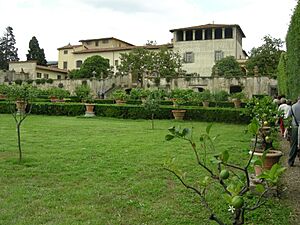
Anna Maria Luisa and Violante Beatrice tried to help Gian Gastone's public image. He rarely appeared in public. They convinced him to make a public appearance in 1729. This was his last public outing.
In 1736, Don Carlos was removed as heir to Tuscany. Francis III of Lorraine was chosen instead. In January 1737, Austrian soldiers took control of Tuscany.
Gian Gastone died on July 9, 1737. Anna Maria Luisa was offered a role as a temporary ruler, but she declined. After Gian Gastone's death, Anna Maria Luisa inherited all the Medici family's private wealth. This included a large amount of money, a huge art collection, and lands.
Her most important act was signing the Patto di Famiglia ("Family Pact") on October 31, 1737. In this agreement, she gave all the Medici family's personal property to the Tuscan state. The condition was that nothing could ever be removed from Florence.
Death and Lasting Impact
Anna Maria Luisa lived quietly in her wing of the Palazzo Pitti. She spent her time overseeing the building of the Cappella dei Principi, a chapel started by Ferdinando I de' Medici, Grand Duke of Tuscany. She also gave a lot of her money to charity.
On February 18, 1743, Anna Maria Luisa de' Medici died. Her death marked the end of the main Medici royal line. She was buried in the Medici Chapel in San Lorenzo. Her will stated that money from her estate should be used to finish the chapel.
Anna Maria Luisa's most important legacy is the Family Pact. This agreement made sure that all the amazing art and treasures collected by the Medici family over nearly 300 years stayed in Florence. This act helped make Florence a major tourist destination. Sixteen years after her death, the Uffizi Gallery, built by Cosimo the Great, was opened to the public.
| Styles of Anna Maria Luisa, Electress of the Palatinate |
|
|---|---|
 |
|
| Reference style | Her Serene Highness |
| Spoken style | Your Serene Highness |
See also
 In Spanish: Ana María Luisa de Médici para niños
In Spanish: Ana María Luisa de Médici para niños


